Author: EVAI
Mercedes-AMG plug-in hybrids recalled for loss of drive power
 Mercedes-Benz has issued a recall for certain plug-in hybrid models from its AMG performance division due to a software error that may cause a loss of drive power. The affected models include the AMG S 63 E Performance, AMG GT 63 S E Performance 4-Door Coupe, AMG GT 63 S E Performance, AMG SL 63 S E Performance, and AMG GLC 63 S E Performance…
Mercedes-Benz has issued a recall for certain plug-in hybrid models from its AMG performance division due to a software error that may cause a loss of drive power. The affected models include the AMG S 63 E Performance, AMG GT 63 S E Performance 4-Door Coupe, AMG GT 63 S E Performance, AMG SL 63 S E Performance, and AMG GLC 63 S E Performance…
Nissan Frontier vs. Toyota Tacoma: Compare Pickup Trucks
 Midsize pickups can do plenty of work, but they can’t match the capability of their larger, more expensive full-size brothers. When that much capability isn’t needed, midsizers provide a more maneuverable, more affordable alternative. The smaller trucks have plenty of fans, as evidenced by the popularity of the 2025 Toyota Tacoma…
Midsize pickups can do plenty of work, but they can’t match the capability of their larger, more expensive full-size brothers. When that much capability isn’t needed, midsizers provide a more maneuverable, more affordable alternative. The smaller trucks have plenty of fans, as evidenced by the popularity of the 2025 Toyota Tacoma…

Nissan taps SK On for US-made EV batteries
SK On will supply batteries to Nissan for U.S.-made electric vehicles, the two companies announced Wednesday in a press release.
Under the agreement, SK On will supply nearly 100 gigawatt-hours of batteries to Nissan from 2028 to 2033. They’ll go into EVs produced at the automaker’s Canton, Mississippi, assembly plant starting in 2028. Nissan plans to build at least four EV models at that plant, spanning both its main brand and Infiniti luxury brand.
This deal “will support” 1,700 U.S. jobs at SK On and involves a $661 million investment. Nissan is spending $500 million to ready the plant for EV production, so not counting other suppliers the total is well over $1 billion.
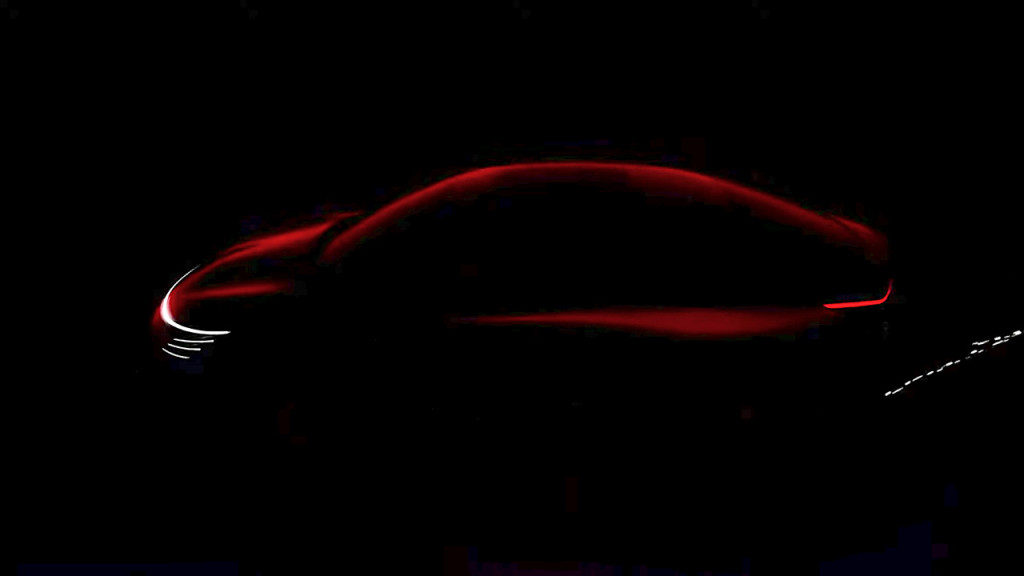
Nissan EV to be made in Mississippi
The deal is an indication that Nissan is finally close to beginning EV production in Canton after multiple delays. In 2022, the automaker originally announced plans to build EVs at the Mississippi plant with a planned 2025 start date. The start was later pushed back to 2027, and then 2028.
Nissan’s Mississippi plant currently makes the gasoline Altima sedan and Frontier pickup truck. SK On currently has two operational U.S. battery plants and is building four more under partnerships. While it currently works with Ford and Volkswagen, among others, this is the first supply agreement between the South Korean firm and a Japanese automaker, Nissan noted.
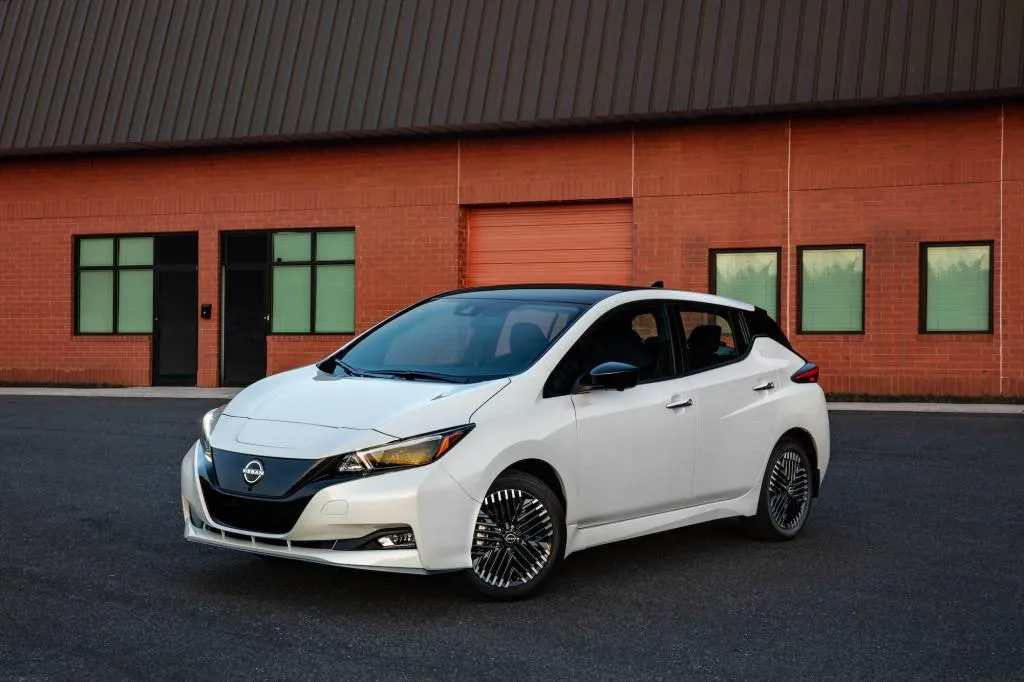
2025 Nissan Leaf
Localized production, with battery manufacturing near vehicle assembly, is something Nissan already planned to emphasize, going back to its Ambition 2030 strategy unveiled in 2021. But the threat of tariffs adds urgency. Honda is reportedly seeking a U.S. battery supply deal with Toyota as a response to that, for example.
After what might have been a completely different future with Honda, Nissan is moving ahead with ambitious product plans announced last year. The Mississippi-built EVs will be among 30 new models the automaker plans to launch globally over the next three years, including 16 electrified models. That cohort will also include a Nissan Rogue hybrid that will finally introduce the automaker’s e-Power hybrid system to the U.S., as well as a next-generation Leaf.
GM taps Nvidia AI chips for automated cars, factories
 General Motors and Nvidia on Tuesday announced an expanded partnership to further leverage artificial intelligence in vehicle development, manufacturing, and the advancement of self-driving cars. GM has already been using Nvidia’s powerful computer chips for training various AI models, but new aspects of the partnership will include using Nvidia’s…
General Motors and Nvidia on Tuesday announced an expanded partnership to further leverage artificial intelligence in vehicle development, manufacturing, and the advancement of self-driving cars. GM has already been using Nvidia’s powerful computer chips for training various AI models, but new aspects of the partnership will include using Nvidia’s…

Mazda is taking on electrified future on its own
Mazda on Tuesday unveiled yet another update to its electrification plans—culminating in what appears to be a more independent approach than the automaker has taken thus far.
The 2025 Mazda CX-50 hybrid uses a Toyota-sourced hybrid system, and the EZ-6 electric sedan was developed in partnership with China’s Changan Automobile. But such partnerships may be limited in the future, Mazda CEO Masahiro Moro and other executives indicated in a presentation held Tuesday in Tokyo.
Mazda is moving ahead with plans, first discussed last November, to launch an in-house developed hybrid system in the CX-5 crossover, as well as an all-electric crossover SUV based a dedicated platform also developed in-house, in 2027. That platform will accommodate “diverse types of batteries,” a Mazda press release said.
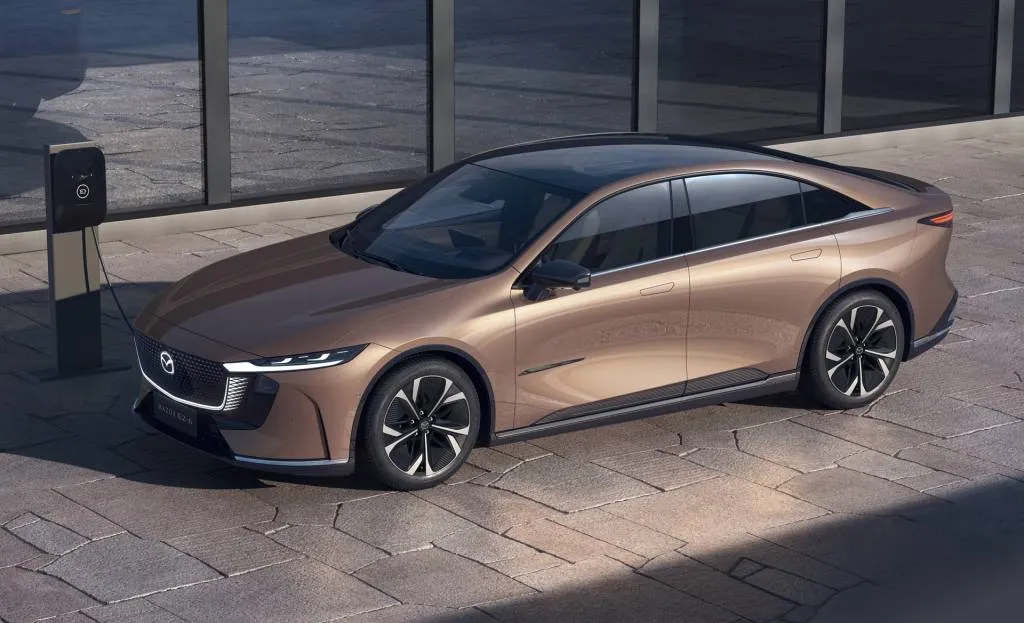
2025 Mazda EZ-6
A next-generation combustion engines, dubbed Skyactiv-Z, aimed at meeting the latest global emissions standards, is also part of the plan. One of these engines, likely an inline-4, due to packaging requirements, will be the combustion component for the CX-5 hybrid powertrain. But Mazda said an inline-6 for larger vehicles will be part of the Skyactiv-Z family as well, and that the underlying tech will be used in continuing rotary-engine development.
Mazda also said that, for the EV it plans to launch in 2027, it aims to “reduce development investment by 40% and development man-hours by 50% compared to conventional development through collaboration and partnership.” No specific partner was named though, indicated that Mazda could lean on suppliers rather than pursuing another partnership like the ones with Toyota and Changan.
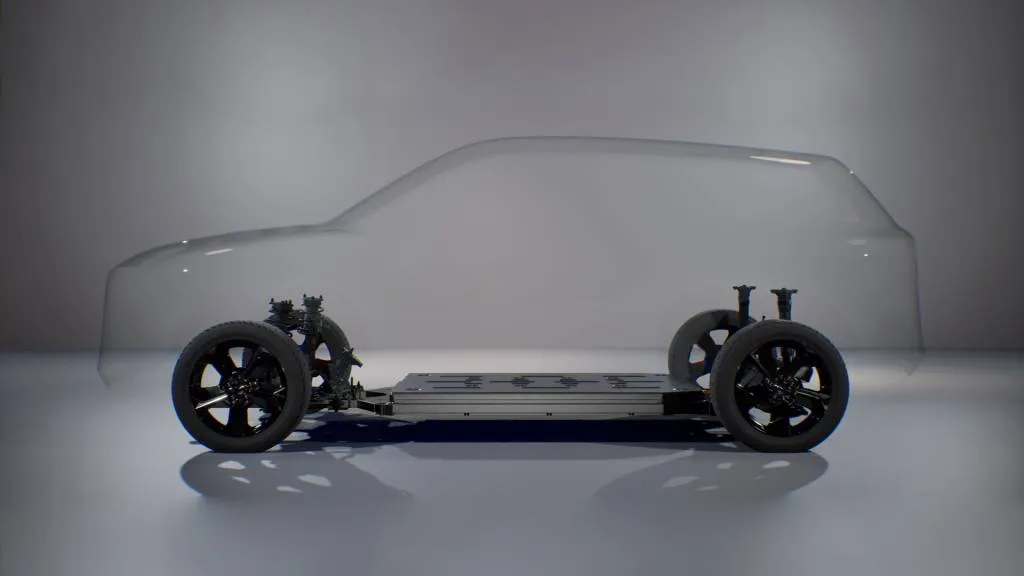
Mazda dedicated EV platform spawning first model in 2027
Going it alone would give Mazda more flexibility to pursue streamlined manufacturing plans, which include producing EVs and internal-combustion vehicles on the same assembly lines. That could reduce initial capital investment by 85% and the time to mass production by 80% compared to building new EV assembly plants, Mazda estimates. The automaker does plan to build a new EV battery factory in Japan, however.
If this goes well, it could play out like Honda sees it, with the EVs informing better internal-combustion models. But Mazda certainly has more limited resources to work with.

Why VW’s cheapest EV may also be its most advanced
- 2027 production form of ID.Every1 concept will debut Rivian zonal architecture for VW
- Sets the stage for modular SSP EVs like ID Golf coming in 2028
- Starting around 20,000 euros, will be VW’s lowest-priced EV yet
Although Volkswagen’s Scout Motors plans to roll out electric trucks with roots in Rivian’s zonal electrical architecture starting in 2027, that same year VW will also debut that zonal architecture in a much more humble, affordable product: the $22,000 ID.1—or whatever it’s badged in production form.
For a time the ID.1 may simultaneously be both the simplest and most tech-advanced EV in the Volkswagen brand’s global lineup, while also carrying the lowest price. VW last week confirmed that it will be the first true software-defined vehicle among its group of brands, which includes Audi and Porsche.
Unlike the Scout electric SUV and pickup, the small EV, previewed by the ID.Every1 concept earlier this month, won’t be coming to the U.S. But last week, Green Car Reports got a first look at the outside of the VW ID.Every1 concept, up close in Dusseldorf, Germany, not only getting a sense of how this boundary-pushing EV will hit unprecedented price targets but also at how VW will adopt that zonal architecture across EVs small to large, simple to luxurious.
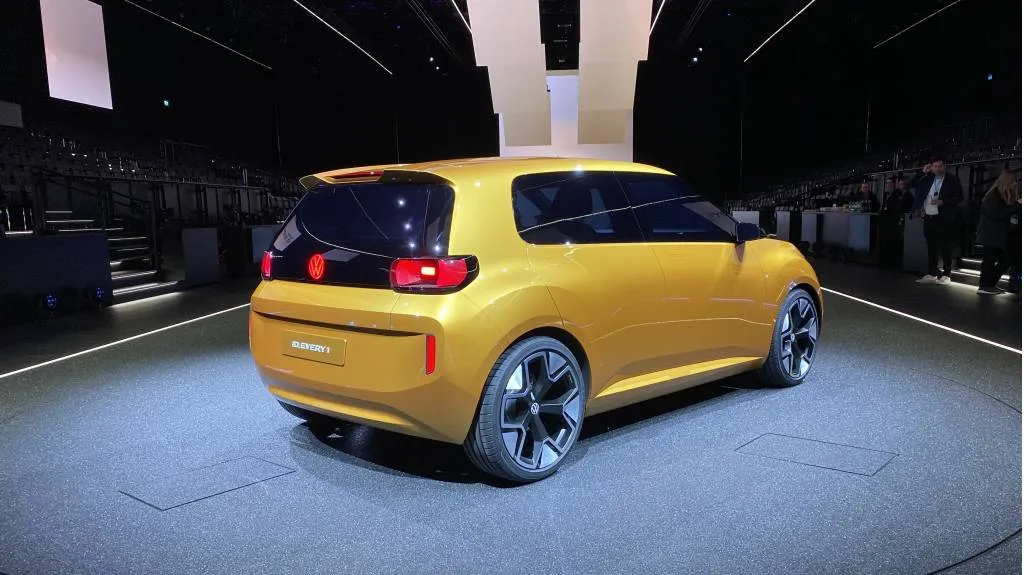
Volkswagen ID.Every1 concept
In a walkaround for Green Car Reports and a few other outlets this past week, VW’s head of design, Andreas Mindt explained that the ID.Every1 isn’t supposed to be a mini-Golf or smaller Polo, or look like the smaller version of anything else in VW’s portfolio—although Mindt does see some likeness to the Mk4 (1999-2004) Golf.
Up close, the 19-inch rims—huge for such a small car—bring the visual weight out to the corners and help ground the proportions, and officials hinted that the production version looks very close to the show car. Mindt emphasized how important it was to have a slim body with a wide track and keep the overall look of the body “super clean,” with no creasing, cladding, or add-on plastic trim, and nothing painted onto it. Take away all the clutter, he explained, “and it looks better, not cheaper.”
Another distinctive feature is the roof which, for this four-seater, is lower in the middle, establishing a sort of double-bubble look that not only results in better aerodynamics but a stronger roof, Mindt noted.
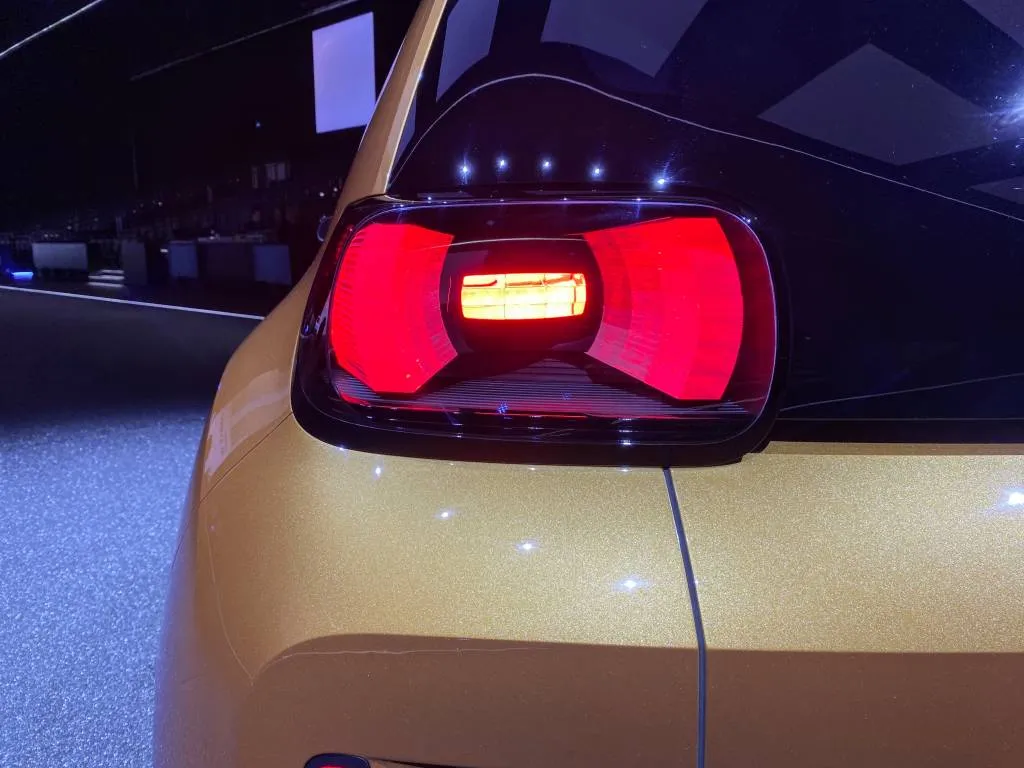
Volkswagen ID.Every1 concept
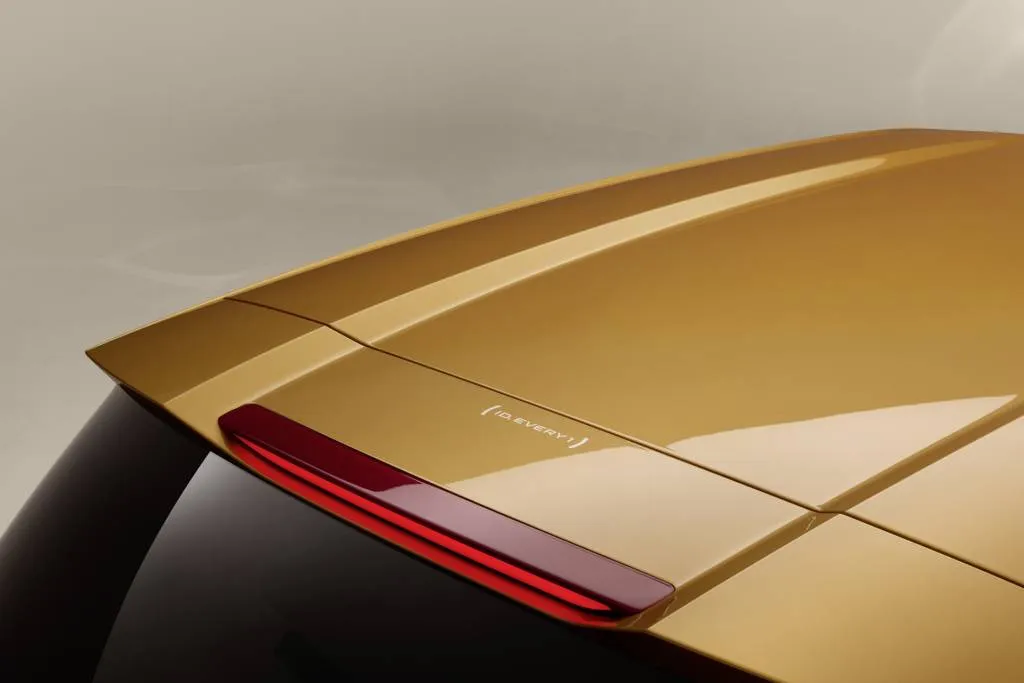
Volkswagen ID.Every1
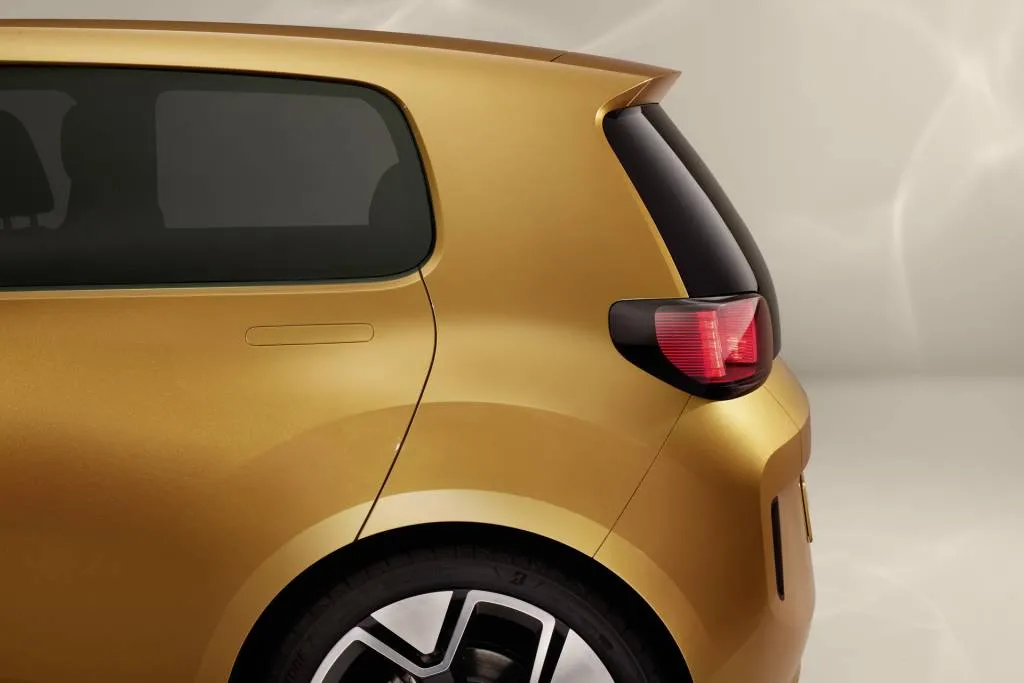
Volkswagen ID.Every1
Getting to this EV’s sub-$22,000 price point
Kai Grünitz, Volkswagen’s global technical development boss, recalled last week next to the concept car that in early 2023, when VW formed the project, it was really hard to define how it might realize an EV with the targeted 20,000 euro price point. So it turned to suppliers for input, and looked at a lot of competitors’ vehicles, especially from China.
In short, the team needed more than the front-wheel-drive “entry” version of VW’s MEB platform shared with the 25,000-euro ID.2, signaled by the 2023 ID.2all concept. The front end of the vehicle is essentially the same as the ID.2, ahead of the front pillar, but from there back they’re very much different cars.
A 70-kw (94-hp) motor is one of the first concessions to cost, then it reduced the overall length compared to ID.2—from 159.4 inches to 152.8 inches, with a shorter overhang. The battery comes from China, and the torsion-beam layout in back started with the current Polo’s rear axle and, Grünitz pointed out, limits how long the battery pack can get because of the layout’s mounting points.
The 1 will have a small battery and a city-driving range. The previous e-Up EV went about the same range on just over 32 kwh of usable capacity (37 kwh gross), and weighed around 2,700 pounds.
In a production model following ID.Every1, LFP cells in the unified cell format will be supplied from China, providing a range of at least 155 miles by European WLTP testing.
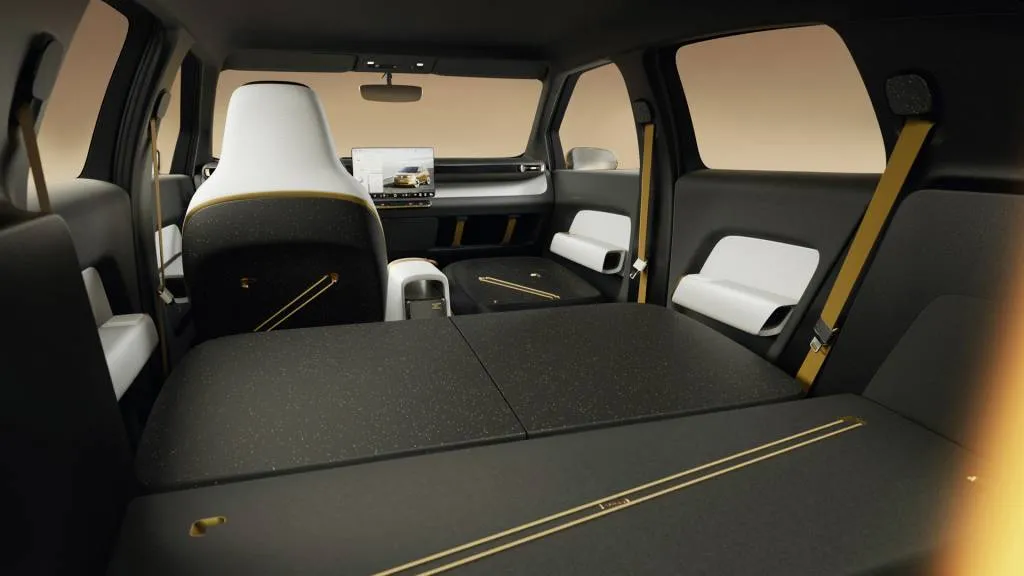
Volkswagen ID.Every1
Fundamentally, the front-wheel-drive layout makes the ID.Every1 and ID.2 less expensive to make versus if it were rear-wheel drive, said Grünitz. In the ID.2 it allows the space for a kind of “basement” at the rear of the vehicle good for two cases of bottles, according to Grünitz, providing 410 liters (14.5 cubic feet) in total, which is 8% more than that of today’s Golf—a size larger car.
Inside, a minimal or omitted center console was one aspect that could cut costs. While the base car will be very clean and simple inside, buyers will be able to add elements that fit customer groups—entertainment-minded young people, for instance, or dog owners. VW even considered eliminating the display screen altogether and emphasizing a bring-your-own device approach, Mindt said, but that didn’t actually save money and it needed a basic interface for usability, so it brought a dedicated screen to the center.
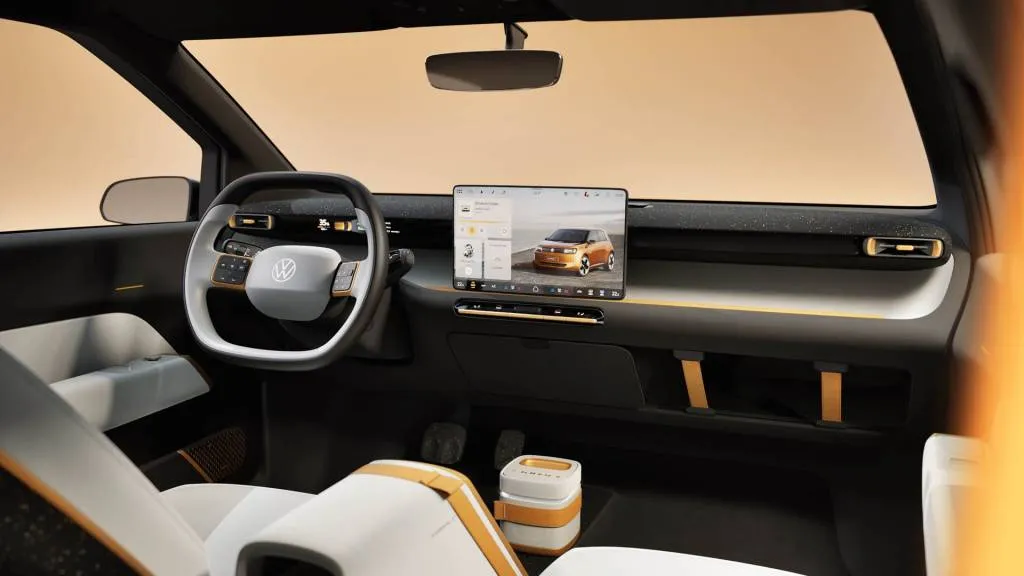
Volkswagen ID.Every1
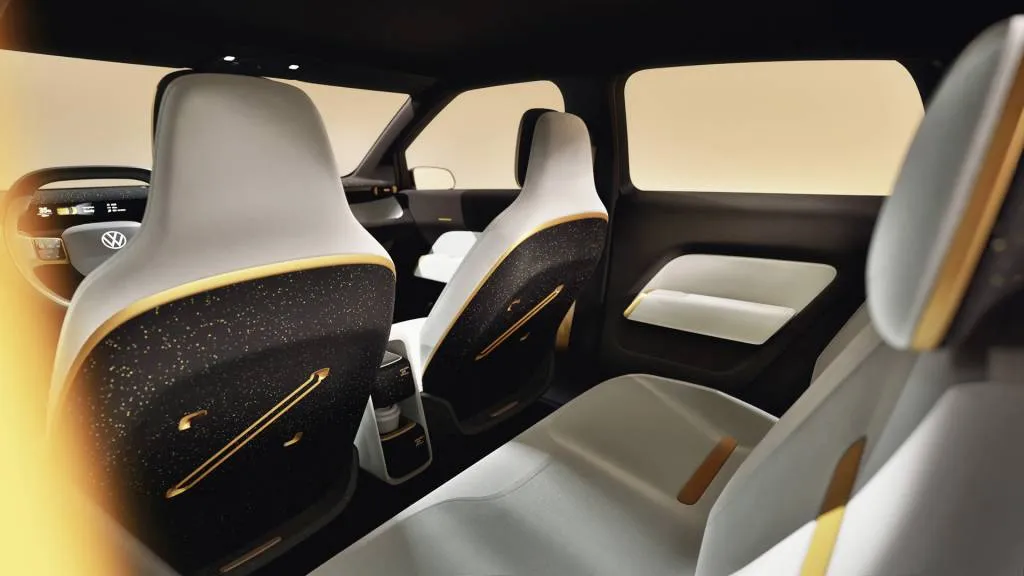
Volkswagen ID.Every1
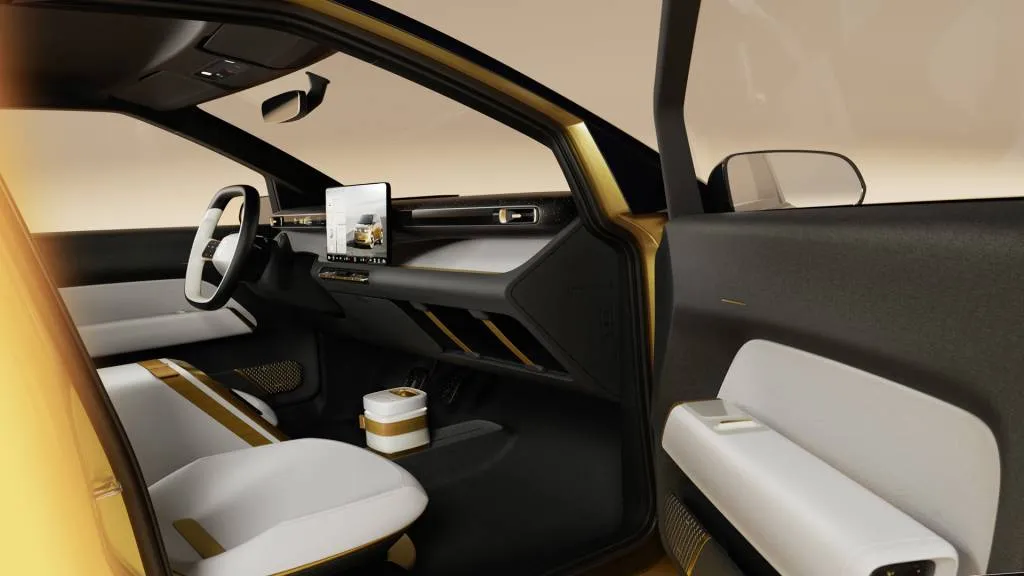
Volkswagen ID.Every1
Also worth pointing out: The ID.Every1 has rear disc brakes, while all of the other current MEB models—even the $60,000 VW ID.Buzz electric van—come with rear drum brakes.
And establishing another clean break from existing VW EVs, don’t expect a numerical name in production. It’ll have what Grünitz referred to as “a real name”—although he emphasized that it’s not yet decided exactly what.
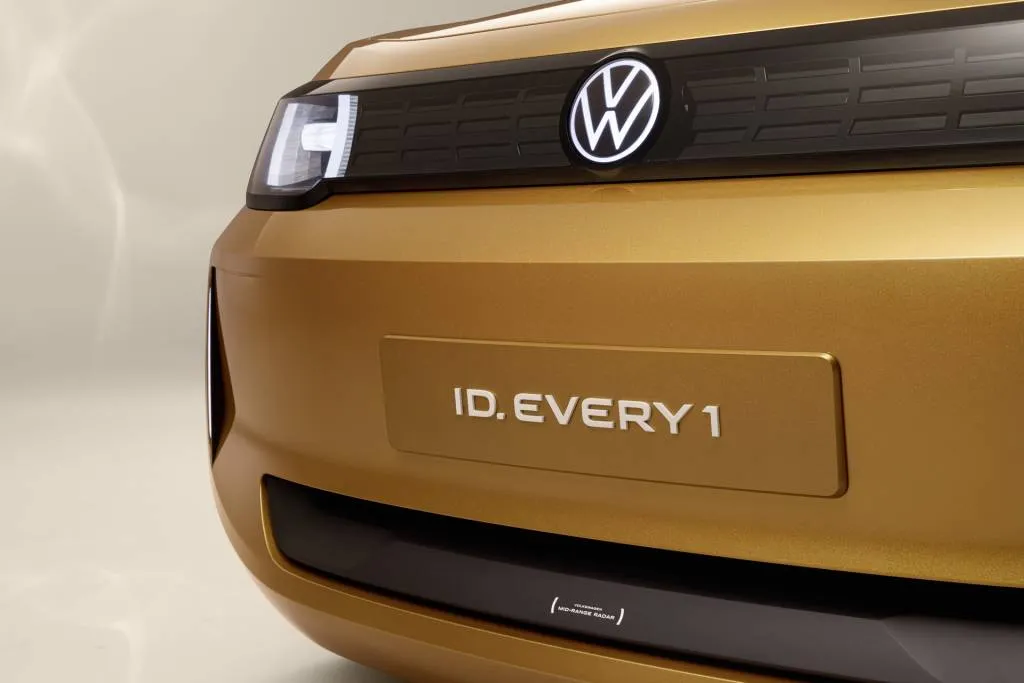
Volkswagen ID.Every1
Small VW EV, big on Rivian architecture
When it arrives in 2027, VW’s tiny ID.1 EV, whatever it might be badged for buyers, will go big on the Rivian-VW electrical architecture while carrying forward with some familiar components. Both the ID.1 and the ID.2 arriving before it in 2026 will use cost-conscious adaptations of components from the MEB platform, but the ID.1 will connect those components in an entirely new way.
As Grünitz explained, it served as a base line of sorts for the zonal architecture. “Usually you have electronic architecture, and this electronic architecture is already defined, and you have the functionalities coming with that architecture,” said Grünitz. “And here we made it the other way around.”
Grünitz said that in the way VW is adopting the Rivian zonal architecture you can have up to four zones. The core zone—the “main compute”—will be the same across most or all vehicles it’s applied to. They’ll use the same SoC (system on chip) family though possibly starting with an SoC with lower power for ID.1, Grünitz said, but the base architecture will be the same across vehicles.
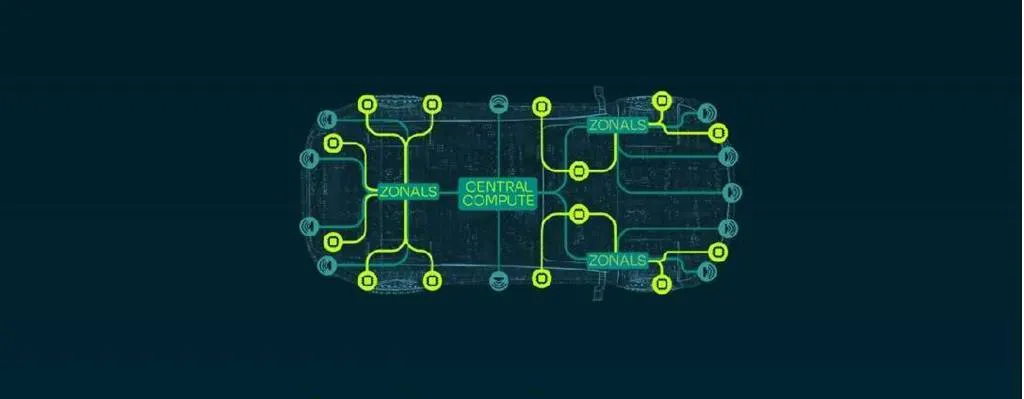
Rivian and Volkswagen Group electrical architecture and software stack
The VW Group’s next-generation Scalable Systems Platform (SSP) will go modular in a new way, allowing combinations of the same core off-the-shelf components to be used in everything from small cars to larger SUVs. Part and parcel with this is the same architecture, which will connect these core components in just a few zones, whereas otherwise in today’s vehicles there would be many dozens of separate controllers.
In other words, there may be much of the same chips, harnesses, and connectors underneath, but various other components enabling luxury and convenience features will be reserved for the vehicles set to be built on SSP—including the upcoming ID Golf, due in 2028 and possibly U.S.-bound.
That means the ID.1 won’t have all the functionality of the SSP vehicles, Grünitz explained, but there will be efforts to add some of it—with a new boot loader, for instance, providing far more over-the-air update capabilities than is possible in MEB vehicles, and essentially the same as what’s coming for SSP.
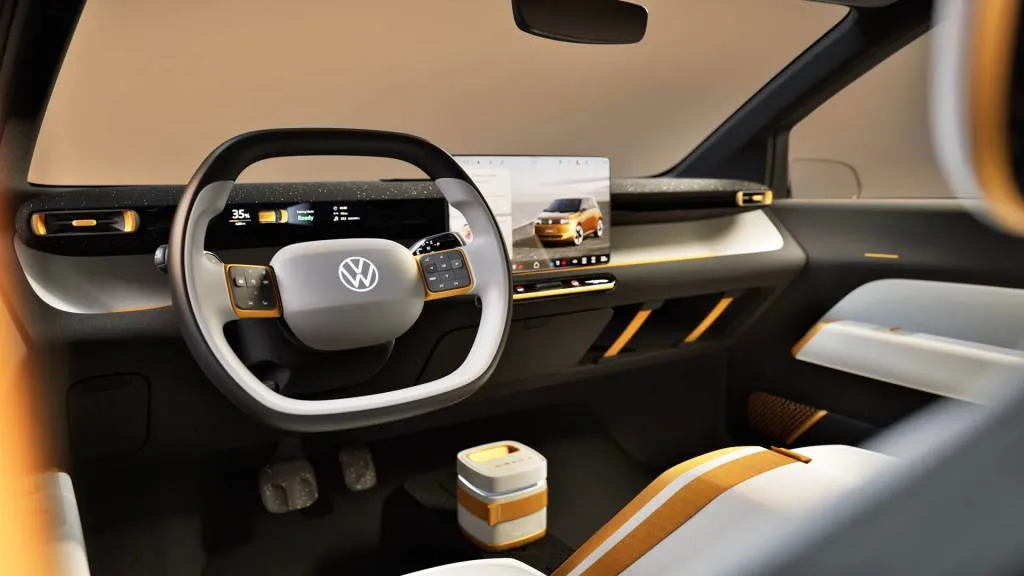
Volkswagen ID.Every1
Despite the modest roots, it’s seeing this entry EV as being a full-on software-defined vehicle. As VW laid out in its reveal of the ID.Every1, it “can be equipped with new functions throughout its entire life cycle.”
Another way to look at it, Grünitz mentioned, is that ID.1 may have about 95% of the zonal architecture of those future SSP vehicles, but not all the components to go with it.
What are some examples of core components VW can keep out of the mix in the $22,000 ID.1?
“It’s an entry vehicle, so this will have a totally different ADAS stack; you don’t need Level 3 driving, for example,” explained Grünitz, noting that it’s still deciding which sensors to package in. But, to put it simply, the ID.1 won’t come with all the redundancies necessary to become a robotaxi down the line.
Ford recalls bevy of trucks and SUVs over trailer brake issue, again
 Ford is recalling 10,627 pickup trucks and SUVs a second time because a trailer-brake software issue may not have been corrected under a previous recall. The list of recalled models includes: 2021-2022 Ford F-150 full-size pickup truck 2022 Ford F-250 heavy-duty pickup truck 2022 Ford F-350 heavy-duty pickup truck 2022 Ford F-450 heavy-duty pickup…
Ford is recalling 10,627 pickup trucks and SUVs a second time because a trailer-brake software issue may not have been corrected under a previous recall. The list of recalled models includes: 2021-2022 Ford F-150 full-size pickup truck 2022 Ford F-250 heavy-duty pickup truck 2022 Ford F-350 heavy-duty pickup truck 2022 Ford F-450 heavy-duty pickup…

California EV carpool lane access ending in 2025
California electric vehicle drivers could lose single-occupancy carpool lane access later this year, Automotive News reported Monday.
The federal law that allows California to grant this perk, one of the earliest such EV ownership incentives, is set to expire Sept. 30, according to the report. California lawmakers reportedly want to extend the statute, but federal lawmakers have not introduced a bill or taken any other action to do so.
The 1998 Transportation Equity Act for the 21st Century allows states to permit carpool lane access for vehicles with only one occupant as long as they are “certified as an inherently low-emission vehicle.” California began issuing decals for qualifying vehicles in 1999, although requirements for the program have changed over time.
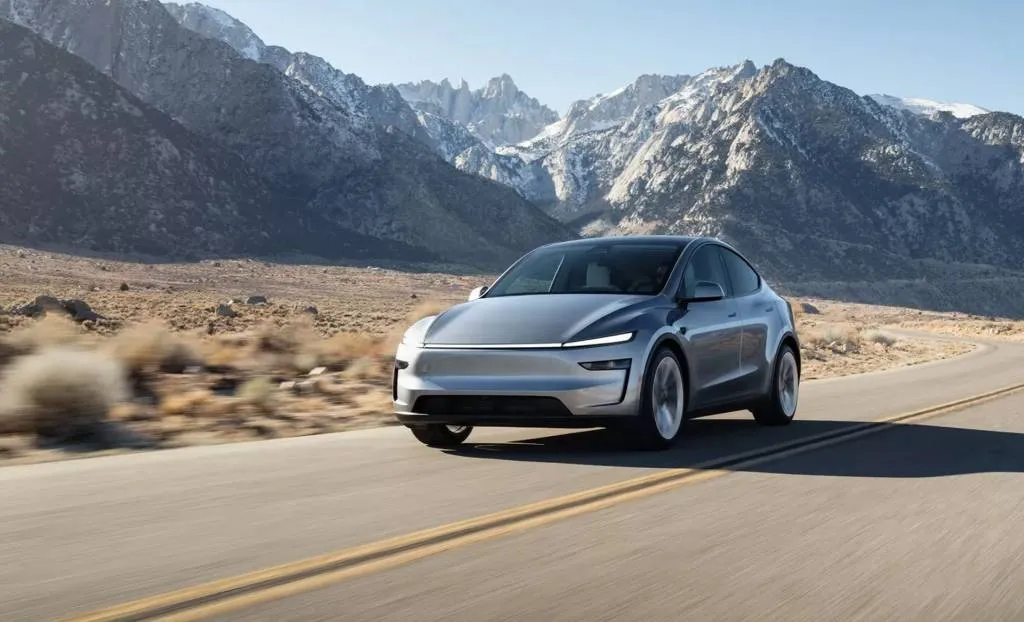
2025 Tesla Model Y
Currently, battery-electric vehicles, hydrogen fuel-vehicles, certain plug-in hybrids, and vehicles powered by compressed natural gas (CNG) qualify for a sticker. In 2024, California’s department of motor vehicles issued 194,486 stickers, a 52% increase over the 128,122 stickers issued in 2023, according to Automotive News.
Greg Wallis, a Republican member of California’s state assembly, has authored a bill extending this status quo to Jan. 1, 2027, pending renewal of the federal law. But that could be a long shot, given that the Republican-controlled Congress is likely to follow the Trump Administration’s lead in attacking EV-friendly policies.
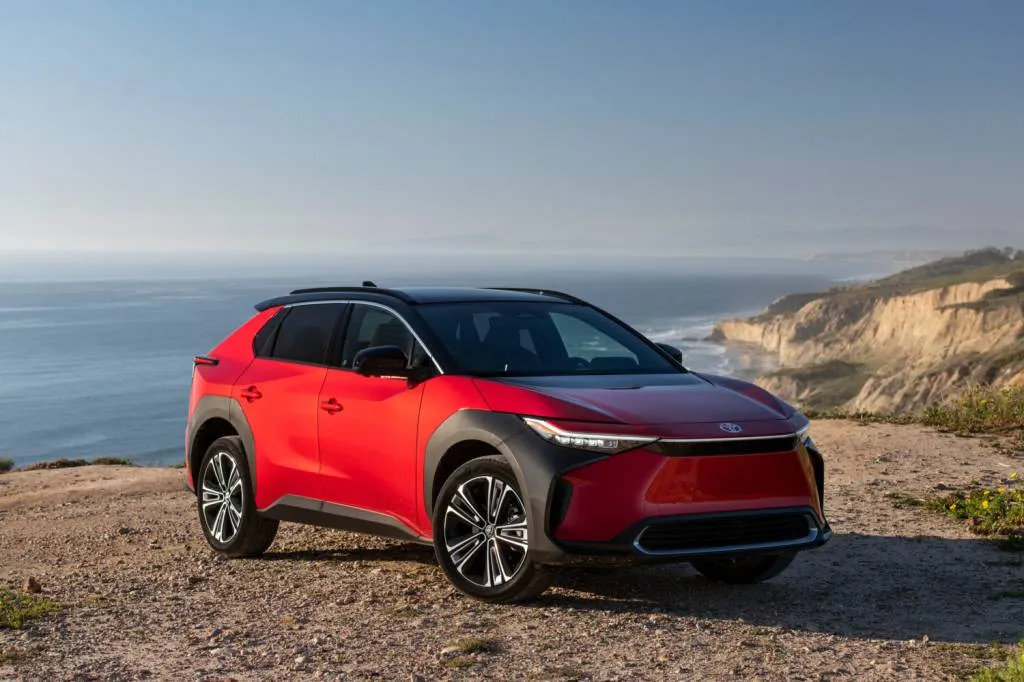
2025 Toyota bZ4X
The Trump-led executive branch has attempted to freeze funding for EV chargers, and is also expected to target the $7,500 federal EV tax credit. California has already pledged to counter these moves, offering an equivalent rebate to its residents and vowing to continue its own EV charger buildout.
But, as pointed out in the Automotive News piece, continuing to offer single-occupancy carpool lane access indefinitely can also limited the effectiveness of carpool lanes, as additional vehicles will eat up the excess capacity that allows traffic to flow more freely than in unrestricted lanes. Encouraging people to carpool is an emissions-reducing policy in its own right, so as more EVs hit the road, carpool lane access for solo drivers will likely have to be phased out eventually, anyway.

Hyundai offering Ioniq 5 and Ioniq 6 buyers a free home charger
Hyundai is further expanding an offer of free home chargers or public-charging credits to buyers of the 2024 and 2025 Ioniq 5 and Ioniq 6 lineups.
This perk was previously offered to owners of the 2025 Hyundai Ioniq 5 N performance variant, and then later the entire 2025 Ioniq 5 mode line, but Hyundai confirmed Tuesday that it’s now available to owners of 2024 and 2025 Ioniq 5 and Ioniq 6 models as well. Customers can choose between a free ChargePoint Home Flex Level 2 charger or a $400 public-charging credit for use at stations on the Ionna, EVgo, Shell Recharge, and ChargePoint networks.
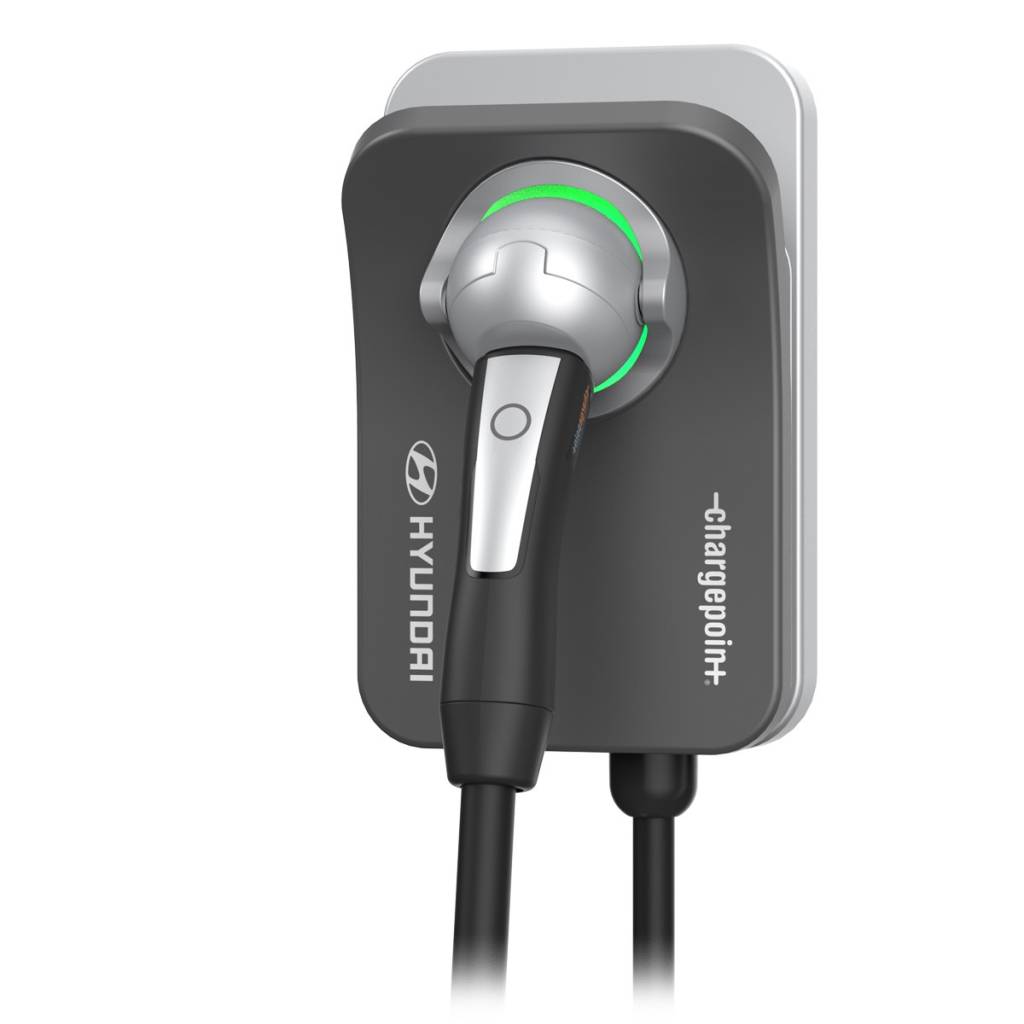
ChargePoint Home Flex Level 2 home charger for 2025 Hyundai Ioniq 5
The home charger is the same unit Hyundai began offering to other EV customers in 2023. Both the charger and installation services are once again offered through the automaker’s Hyundai Home service, which aggregates home-charging possibilities for EV owners, as well as solar and energy storage options, and provides bids for installation.
As with the previous offer for Ioniq 5 N customers, Hyundai is requiring hardwired installation, but the offer doesn’t include hardwired installation costs. Customers who purchased or leased a new 2025 Ioniq 5 after Jan. 1, 2025, have 60 days to choose the free home charger or charging credit, and 120 days to complete hardwired installation for the home charger. The public-charging credit is good for two years. The same offer now expands to 2025 Ioniq 6 and 2024 Ioniq 5 and Ioniq 6 models purchased or leased after March 1.
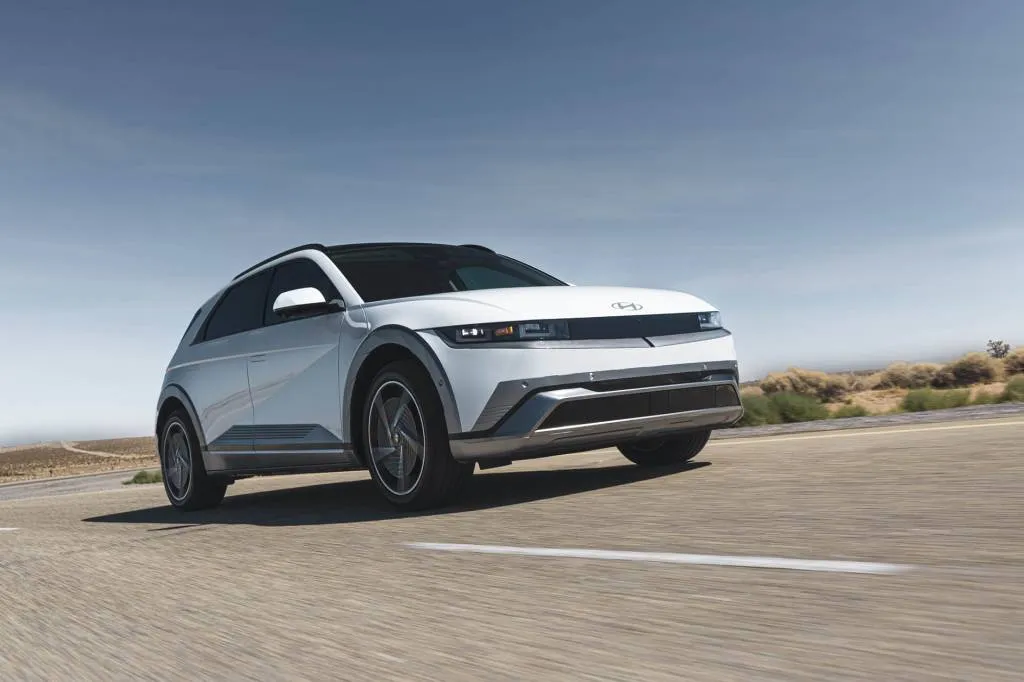
2025 Hyundai Ioniq 5
The Ioniq 5 N, we’ve found, resets expectations for enthusiast EVs with genuine track capability and handling prowess to complement the brutal straight-line acceleration many EVs already offer. But the 2025 Ioniq 5 gets a number of notable updates, too.
Hyundai increased the size of the two available battery packs, boosting estimated range to 318 miles with the larger pack. Charging for all but the 5 N is now accomplished with a Tesla-style NACS connector; a new XRT grade brings off-road features; and all versions feature small styling changes. Hyundai is also shifting most Ioniq 5 production—5 N version aside—to its Georgia “Metaplant.”
Note—This story was updated to reflect an expansion of the program by Hyundai in February to include more models
Mazda dedicated EV platform spawning first model in 2027
 Mazda currently uses a platform dedicated to electric vehicles in its EZ-6 electric sedan, which is sold in China. However, the platform, known as EPA1, is sourced from Chinese automaker Changan. Mazda is now developing its own dedicated EV platform, which is set to debut in 2027. On Tuesday, Mazda provided a first look at the platform, which…
Mazda currently uses a platform dedicated to electric vehicles in its EZ-6 electric sedan, which is sold in China. However, the platform, known as EPA1, is sourced from Chinese automaker Changan. Mazda is now developing its own dedicated EV platform, which is set to debut in 2027. On Tuesday, Mazda provided a first look at the platform, which…





